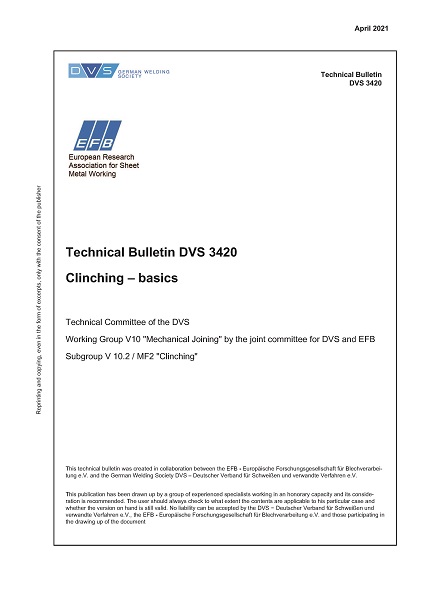Clinching – basics
Medien-Nr.:
MB-3420e
Produktnummer:
MB_3420e_0
Herausgeber:
Europäische Forschungsgesellschaft Blechverarbeitung e.V. und DVS – Deutscher Verband für Schweißen und verwandte Verfahren e.V. - Gemeinschaftsausschuss "Mechanisches Fügen"
Erscheinungsjahr:
1. April 2021
Seitenanzahl:
26
This technical bulletin is intended to provide the users of the joining technology clinching an overview and information on component design, suitable metallic materials, technology and the quality assurance.
Clinching is a type of “joining by forming” (DIN 8593-5) [1; 2].
It is the joining of two or more overlapping sheet metal, pipe and/or profile parts by cold-forming using a punch and die. A joint partial penetration of the join partners - the joining part material is partially displaced out of the plane - and subsequent upsetting take place, creating an inseparable joint by squeezing and/or extrusion. This joint (also known as a joining element) is form- and force-fitting. In certain cases material bonding was also detected. Additional joining elements (auxiliary joining parts) are not used. Auxiliary materials such as oils or volatile liquids may be required for clinching of dry material surfaces.
Clinch joints are generally used to make mechanical and electrical joints. In both applications, the outstanding joint properties are cost-effective, safe to monitor and robust. Two-sided accessibility is required.
It is the joining of two or more overlapping sheet metal, pipe and/or profile parts by cold-forming using a punch and die. A joint partial penetration of the join partners - the joining part material is partially displaced out of the plane - and subsequent upsetting take place, creating an inseparable joint by squeezing and/or extrusion. This joint (also known as a joining element) is form- and force-fitting. In certain cases material bonding was also detected. Additional joining elements (auxiliary joining parts) are not used. Auxiliary materials such as oils or volatile liquids may be required for clinching of dry material surfaces.
Clinch joints are generally used to make mechanical and electrical joints. In both applications, the outstanding joint properties are cost-effective, safe to monitor and robust. Two-sided accessibility is required.
Content
1. Purpose and scope of the technical bulletin
2. Fundamental principles
2.1. Terms and definitions
2.2. Classification of clinch joints
2.3. Process variants
2.3.1. Single-stage, round clinching process without cutting element
2.3.2. Single-stage, round clinching process with cutting element or pre-punched hole
2.3.3. Single-stage, non-round clinching process
2.3.4. Clinching with low or no button protrusion
2.4. Designations
2.5. Joint properties
2.5.1. Quasistatic load
2.5.2. Fatigue load
3. Design
3.1. Symbolic representation on drawings
3.2. Constructive component design
3.2.1. Arrangement of the components
3.2.2. Component dimensions at the join (design guidelines)
3.3. Suitability of materials for clinching
3.3.1. Parent materials
3.3.2. Workpiece surface coating / condition
4. Production
4.1. Machinery and equipment
4.2. Technological parameters and process information
4.2.1. Joining distance, joining and downholder force
4.2.2. Tool wear and life time
5. Quality assurance
5.1. Non-destructive test
5.1.1. Visual inspection
5.1.2. Checking the bottom thickness and outer diameter
5.1.3. Online testing (process monitoring)
5.1.4. Tool inspection
5.2. Destructive test
5.2.1. Macrosection (Cross Section)
5.2.2. Strength analysis
6. Reworking and repairs
7. Occupational safety and environmental protection
7.1. Occupational safety
7.2. Environmental protection
8. Alternative processes
8.1. Pulsed tool movement
8.2. Overlaid tool movement
8.3. Clinching with flat anvil and die-side button protrusion
9. References
1. Purpose and scope of the technical bulletin
2. Fundamental principles
2.1. Terms and definitions
2.2. Classification of clinch joints
2.3. Process variants
2.3.1. Single-stage, round clinching process without cutting element
2.3.2. Single-stage, round clinching process with cutting element or pre-punched hole
2.3.3. Single-stage, non-round clinching process
2.3.4. Clinching with low or no button protrusion
2.4. Designations
2.5. Joint properties
2.5.1. Quasistatic load
2.5.2. Fatigue load
3. Design
3.1. Symbolic representation on drawings
3.2. Constructive component design
3.2.1. Arrangement of the components
3.2.2. Component dimensions at the join (design guidelines)
3.3. Suitability of materials for clinching
3.3.1. Parent materials
3.3.2. Workpiece surface coating / condition
4. Production
4.1. Machinery and equipment
4.2. Technological parameters and process information
4.2.1. Joining distance, joining and downholder force
4.2.2. Tool wear and life time
5. Quality assurance
5.1. Non-destructive test
5.1.1. Visual inspection
5.1.2. Checking the bottom thickness and outer diameter
5.1.3. Online testing (process monitoring)
5.1.4. Tool inspection
5.2. Destructive test
5.2.1. Macrosection (Cross Section)
5.2.2. Strength analysis
6. Reworking and repairs
7. Occupational safety and environmental protection
7.1. Occupational safety
7.2. Environmental protection
8. Alternative processes
8.1. Pulsed tool movement
8.2. Overlaid tool movement
8.3. Clinching with flat anvil and die-side button protrusion
9. References

